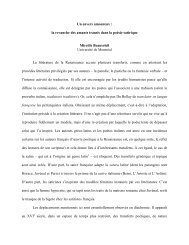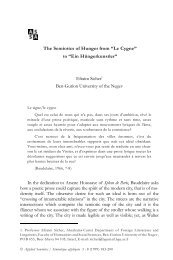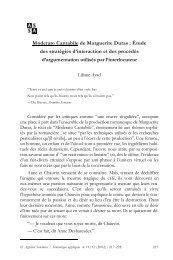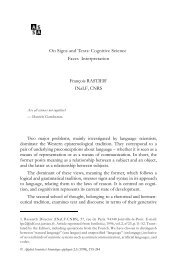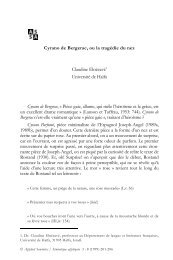“Beannacht libh, cried Miss Ivors” Translating James Joyce: Culture ...
“Beannacht libh, cried Miss Ivors” Translating James Joyce: Culture ...
“Beannacht libh, cried Miss Ivors” Translating James Joyce: Culture ...
You also want an ePaper? Increase the reach of your titles
YUMPU automatically turns print PDFs into web optimized ePapers that Google loves.
whereas Fernandez adds only the name of the author. Although these two choices produce<br />
different levels of comprehension, they are similar on a strategic level. Indeed, both translators<br />
considered that this item required an explanation. This is the only occurrence, out of the selected<br />
examples, where they agree that extra information is needed. In other cases, the translators react<br />
differently to the CSIs and seem to decide to add information when they personally feel it is<br />
needed. For instance, while Aubert simply borrows the term “O’Connell Bridge”, Fernandez<br />
translates it as “le pont O’Connell”. It seems that Fernandez believed borrowing the term would<br />
alter the reader’s comprehension and she consequently went for “pont” rather than “bridge”.<br />
However, in another instance, Fernandez completely mystifies the reader. She borrows the Gaelic<br />
expression <strong>“Beannacht</strong> <strong>libh</strong>” 38 without adding any extra information to explain the meaning of<br />
this idiom. The level of comprehension conveyed to the target readership here is virtually<br />
nonexistent. The reader of the translation must be left to wonder what language this is and what it<br />
means. Aubert’s translation contrasts greatly with hers as he chooses to use a translator’s note<br />
explaining the meaning of the CSI. The implications of these choices for the readership are<br />
opposed: Fernandez’s reader will be mystified whereas Aubert’s will be provided with the<br />
information s/he needs to understand the CSI. This leads me to a first general observation on the<br />
act of translation: translators add dissimilar information at different places, thus conveying<br />
varying levels of restitution of the original message.<br />
Notice the instances where both translators agree that no extra information is needed.<br />
Neither translator felt the CSIs “Robert Browning”, “Daily Express”, “University question”, “the<br />
river”, “the park”, “the statue”, or “Dan” required extra explanation for the target readership.<br />
Both translators either borrowed these items or used literal translation. These choices are quite<br />
surprising because they convey a low level of restitution of the source message for the target<br />
readership. Unless her/his personal curiosity pushes her/him to research what the “University<br />
12





